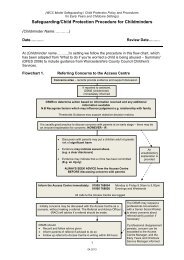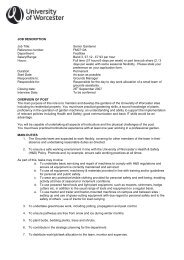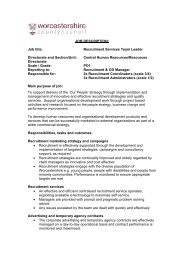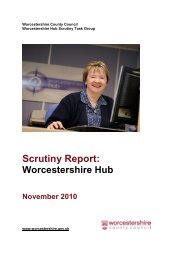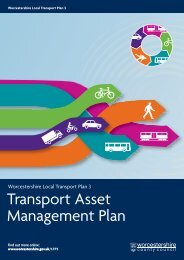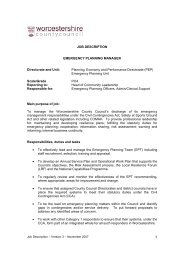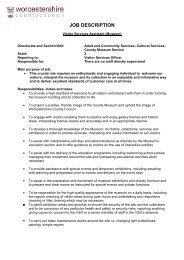Planning for Renewable Energy in Worcestershire Research Paper
Planning for Renewable Energy in Worcestershire Research Paper
Planning for Renewable Energy in Worcestershire Research Paper
You also want an ePaper? Increase the reach of your titles
YUMPU automatically turns print PDFs into web optimized ePapers that Google loves.
9. COMMUNITY & STAKEHOLDER ● <strong>Plann<strong>in</strong>g</strong> <strong>for</strong> <strong>Renewable</strong> <strong>Energy</strong> <strong>in</strong> <strong>Worcestershire</strong>9. Community and Stakeholder Consultation9.1 A national survey was conductedon behalf of the Department of Trade andIndustry on '<strong>Renewable</strong> <strong>Energy</strong>Awareness and Attitudes' <strong>in</strong> May 2006 24 .85% of respondents supported the use ofrenewable energy, with 78% support<strong>in</strong>gthe Government's policy of generat<strong>in</strong>g10% of electricity needs from renewablesby 2010.9.2 The <strong>Worcestershire</strong> Citizens'Panel Survey of June 2007 <strong>in</strong>cludedquestions on climate change, energyefficiency and renewable energy. Theresults <strong>in</strong>dicate a clear desire to helpaddress climate change and to <strong>in</strong>creasethe use of renewable energy. The resultsshow that, <strong>for</strong> <strong>Worcestershire</strong> residents:90% either support or stronglysupport the generation of renewableenergy with<strong>in</strong> <strong>Worcestershire</strong> (Q12).51% consider it a high priority thatnew development has a m<strong>in</strong>imumamount of its energy generatedrenewably on-site, with just 9%feel<strong>in</strong>g this is a low priority (Q13c).65% consider improv<strong>in</strong>g energyefficiency <strong>in</strong> exist<strong>in</strong>g build<strong>in</strong>gs to bea high priority. Only 4% feel this is alow priority (Q13a).69% consider it a high priority toconstruct extremely energy efficientbuild<strong>in</strong>gs. 4% feel this is a lowpriority (Q13b).23% consider the <strong>in</strong>stallation oflarge w<strong>in</strong>d turb<strong>in</strong>es/w<strong>in</strong>d farms tobe a high priority, whereas 33% seethis as a low priority.46% consider generat<strong>in</strong>g hydroelectricityfrom the County's riversand streams to be a high priority,with 11% feel<strong>in</strong>g this is a lowpriority.These results provide a useful <strong>in</strong>dicationnot only of people's general support <strong>for</strong>renewables, but also of the k<strong>in</strong>d ofrenewables technologies that they favour.The responses <strong>in</strong>dicated that people feeldifferently about build<strong>in</strong>g-mountedrenewables depend<strong>in</strong>g on whether they'remounted on homes or on offices/<strong>in</strong>dustrialbuild<strong>in</strong>gs. In the case of both solar panelsand micro-w<strong>in</strong>d turb<strong>in</strong>es, residentialbuild<strong>in</strong>gs received fewer responsesstat<strong>in</strong>g their <strong>in</strong>stallation was a 'highpriority' than offices/<strong>in</strong>dustrial build<strong>in</strong>gs(see Figs 1 and 2). These responsesunderl<strong>in</strong>e the necessity of ensur<strong>in</strong>g thatresidential amenity rema<strong>in</strong>s a keyconsideration <strong>in</strong> plann<strong>in</strong>g <strong>for</strong> renewables.However, it must be recognised thatunder a revised householder permitteddevelopment scheme, certa<strong>in</strong>microgeneration technologies will fallbeyond local authority developmentcontrol.24<strong>Renewable</strong> <strong>Energy</strong> Awareness and Attitudes <strong>Research</strong>(DTI/NOP tracker survey published 24 May 2006)22Technical <strong>Research</strong> <strong>Paper</strong>




